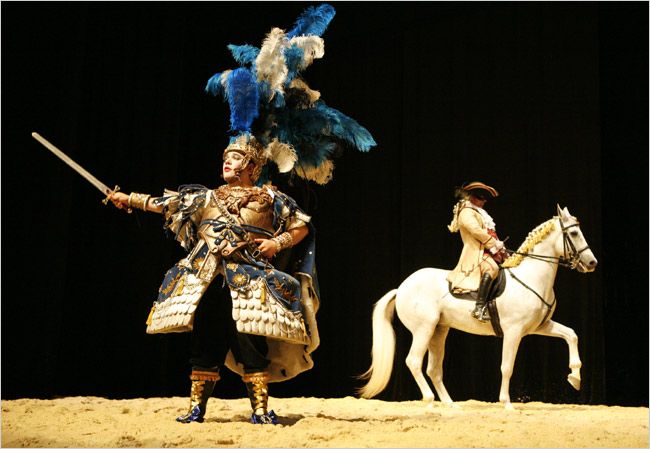
A history of the castrati doesn’t sound like an obvious theme for a theatre production. But at least it’s different. And difference is interesting. It becomes even more interesting, when it is told by a pair of Siamese twins accompanied by harpsichord. Add to this a horse, a eunuch, a centaur and a singer whose vocal range approaches that of a castrato and you’ve got the unlikely cast of De Monstruos y Prodigios (Monsters and Prodigies) directed by Claudio Valdés Kuri and performed by the Mexican company Teatro de Ciertos Habitantes.
In case you don’t know, castrati were singers who had been castrated at an early age to retain their high vocal range. The practice commenced in the 16th century when women were banned from singing in church choirs, reaching its peak in the early 18th century at the height of the baroque.
The play begins with the centaur recounting how, in the Middle Ages, deformed children were regarded as monsters. In the subsequent scenes the Siamese twins Jean and Ambroise Paré, one a surgeon the other an opera critic, guide the audience through three centuries of musical history. They argue about taste and indulge in gossip. They are joined on stage by a castrato.
At first the castrato, played by Javier Medina, a singer who, because of an illness during his youth, has an unnaturally high voice, sings rather timidly. But as history unfolds and the castrati become more popular, he returns in ever more grandiose costumes singing ever greater arias.
At the height of excess and decadence, with the castrato dressed in a grotesque costume indulging in a fabulous meal, a man in the audience got up and addressed the eunuch/slave calling him a jerk and an idiot for letting himself being pushed around the stage by the other actors. The actors stopped playing. Some people in the audience started booing, urging the man to take his seat. Then all of a sudden all actors started launching bread rolls at the audience. People in the audience threw the bread rolls back towards the stage and in the direction of the man who had stood up. Since my seat was somewhere in the middle, I found myself in the middle of fire, so to say.
Now it is power to the people. The singers burst into fragments of popular Dutch songs, one of which, an old carnival song that everyone in Holland knows, was actually called Mexico Mexico.
The anarchy came to a halt when suddenly an actor on horseback dressed as Napoleon Bonaparte appeared on stage. After chasing the other actors around the stage he retreated and returned with a cannon, which he aimed right at the audience. When the smoke had cleared the centaur lay shattered on stage, his lower back blown off. The siamese twins had been separated and were now wandering about in rags. The castrato appeared to have lost his voice. After having been harassed for much of the show the eunuch/slave now took centre stage. A symbol of emancipation.
Of course, the heckler was part of the show and it wasn’t the first time I’d been thrown stuff at during a theatre performance. But it worked because the entire scene made sense on multiple levels. The audience uprising was a re-enactment of the kind of protests that were frequently being heard in opera houses at this particular moment in musical history. It was also a theatrical metaphor of the French revolution and of the clash between the rational Enlightment that had taken root in France and the decadence of 18th century Italian culture.
I thought De Monstruos y Prodigios was quite brilliant and it made up for the other rather mediocre productions during this year’s Holland Festival. Perhaps I’m reading too much into it. The dressage number seemed to me a metaphor of the strict regime singers, ballet dancers and indeed the horse have to adhere to in order to reach the apex of beauty. There is also an obvious parallel between the castrati and the obsession with bodily beauty in our visual culture. In pursuit of an ideal of youth and beauty women now turn to dieting, botox and plastic surgery.
A change of taste during the 19th century spelled the decline of the castrati. In 1902 the Vatican officially prohibited the hiring of new castrati and the last castrato died in 1922. All that remains today is a handful of vintage recordings. In the final scene the castrato is sitting alone on stage, weeping, as the grating voice from an old audio recording sounds through a set of speakers. It is the melancholy for an age gone by, for ethereal beauty that has had to make way for reason and popular culture, for a life dedicated to an artform that has been overtaken by time and for the countless lives that were ruined in the name of art.